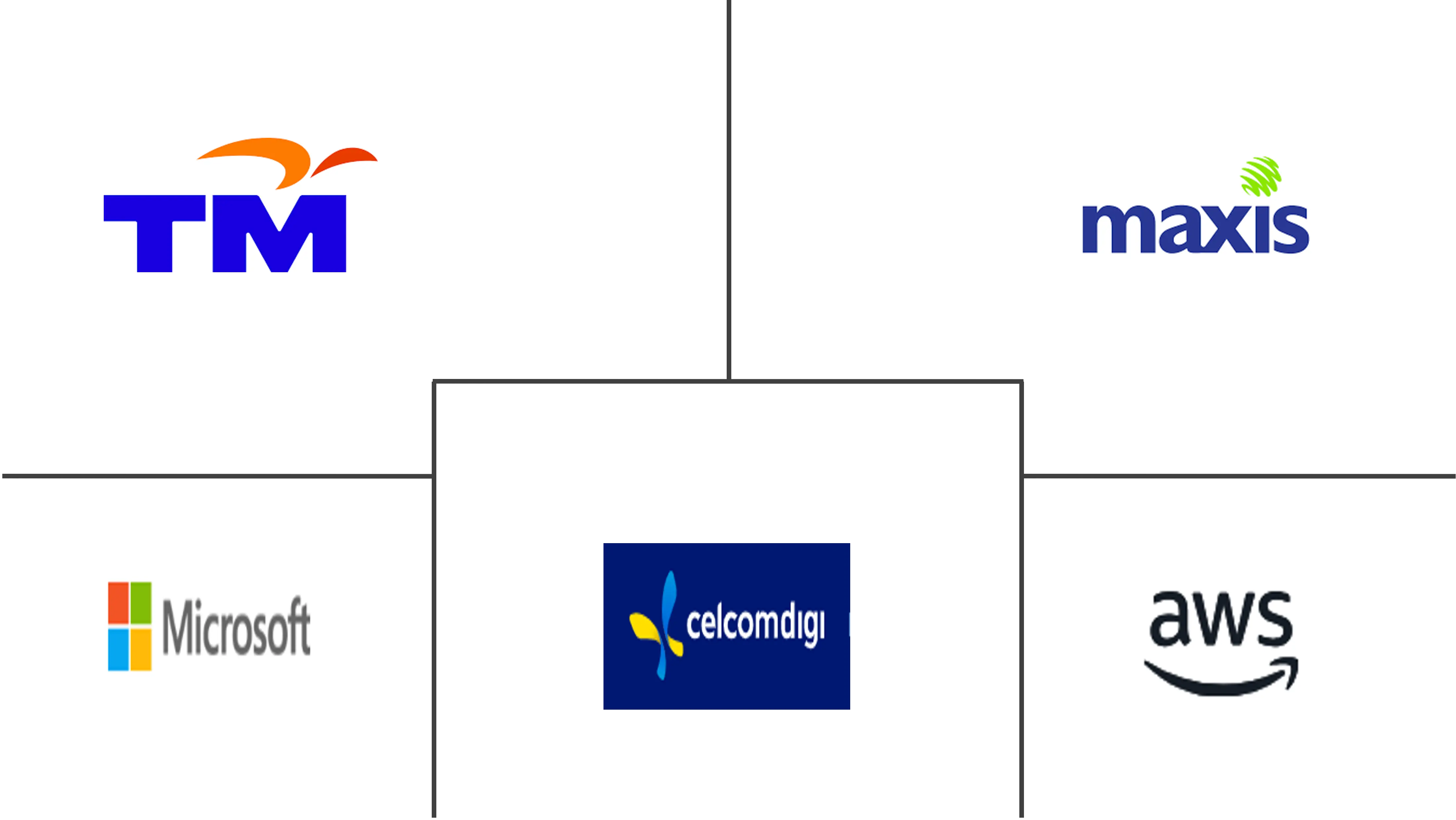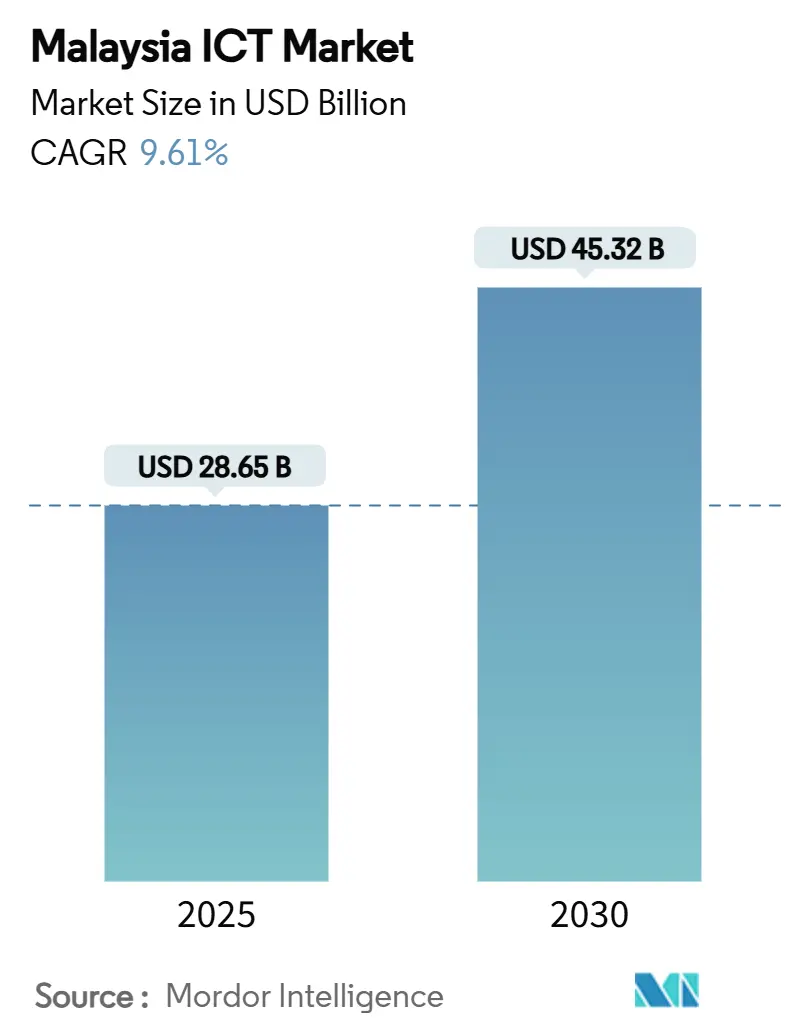
Malaysia ICT Market Analysis by Mordor Intelligence
The Malaysia ICT market size reached USD 28.65 billion in 2025 and is on course to hit USD 45.32 billion by 2030, reflecting a 9.61% CAGR. This rapid growth is propelled by the MyDIGITAL blueprint, hyperscale data-center commitments from Google, Microsoft, and Oracle, and accelerated 5G deployment. Foreign direct investment responds to Malaysia’s clear cloud-first mandates, while local firms leverage coordinated tax incentives to digitize operations. Demand momentum concentrates in Kuala Lumpur, Selangor, and Penang, yet targeted rural programs under JENDELA extend connectivity to underserved regions. Competition is intensifying as telecom operators, cloud hyperscalers, and software specialists converge around enterprise digital-transformation contracts, elevating service quality and opening white-space opportunities for SME-focused solutions.
Key Report Takeaways
- By type, IT Infrastructure held 30.2% of the Malaysia ICT market share in 2024, while IT Software is advancing at a 15.9% CAGR through 2030.
- By deployment model, on-premise accounted for 59.2% of the Malaysia ICT market size in 2024, and cloud services are expanding at an 18.2% CAGR over the forecast window.
- By enterprise size, large enterprises controlled 71.2 of % revenue in 2024, whereas SMEs registered the fastest 11.3% CAGR to 2030.
- By end-user vertical, BFSI led with 23.2% share in 2024, and manufacturing & Industry 4.0 is projected to post the highest 17.2% CAGR through 2030.
- Klang Valley captured the largest regional contribution in 2024, and Penang’s semiconductor corridor is forecast to chart the quickest growth pace through 2030.
Malaysia ICT Market Trends and Insights
Drivers Impact Analysis
| Driver | (~) % Impact on CAGR Forecast | Geographic Relevance | Impact Timeline |
|---|---|---|---|
| MyDIGITAL & 12th Malaysia Plan execution | +2.1% | Kuala Lumpur, Selangor, Penang | Medium term (2-4 years) |
| National 5G rollout under JENDELA & DNB | +1.8% | Urban centers then rural | Short term (≤ 2 years) |
| Cloud-first policy catalyzing hyperscale builds | +1.5% | Selangor, Kuala Lumpur, Johor | Medium term (2-4 years) |
| SME digital-tax incentives & matching grants | +1.2% | Nationwide manufacturing hubs | Short term (≤ 2 years) |
| Semiconductor strategy & IC-design funding | +0.9% | Penang, Kedah, Selangor | Long term (≥ 4 years) |
| Google/Microsoft AI-talent programs | +0.7% | Major university cities | Medium term (2-4 years) |
| Source: Mordor Intelligence | |||
MyDIGITAL & 12th Malaysia Plan execution push
The twin policy frameworks synchronize public-sector cloud adoption, private-sector tax incentives, and AI mandates. Government agencies must migrate selected workloads to accredited clouds, while the National Artificial Intelligence Office coordinates cross-agency AI pilots that already reach 445,000 civil servants [1]Google Cloud Press Team, “Advancing Malaysia Together,” googlecloudpresscorner.com. Predictable regulatory timelines attract multiyear commitments from hyperscalers and reduce investor uncertainty relative to neighboring markets. The framework also expands MDEC’s remit beyond Multimedia Super Corridor zones, creating a single window for nationwide technology incentives. Together, these measures lift enterprise confidence and widen the total addressable base for software-as-a-service, analytics, and cybersecurity solutions within the Malaysia ICT market.
National 5G rollout under JENDELA & DNB model
The single-wholesale plus second-network design speeds coverage while preserving competition. Digital Nasional Berhad’s Ericsson-built grid reached 40% 5G adoption among mobile subscriptions by 2025 [2]GSMA Intelligence, “5G and the Tech Economy in Malaysia,” gsma.com. U Mobile’s license to build a parallel 5G network with Huawei injects fresh capital and innovation, minimizing latency for industrial use-cases in logistics and smart factories. Rural spectrum targets under JENDELA complement urban densification, limiting the digital divide that once restrained the Malaysia ICT market. The Malaysian Communications and Multimedia Commission enforces spectrum-sharing rules that curb redundant capex and stabilize tariffs.
Cloud-first policy catalyzing hyperscale builds
Mandatory cloud adoption among ministries produces anchor loads that justify multibillion-dollar campuses. Google committed USD 2 billion for its first Malaysian data center in Selangor. Oracle earmarked USD 6.5 billion for AI-optimized cloud zones, while Microsoft pledged USD 2.33 billion for parallel facilities [3]Oracle Communications, “Oracle to Invest More Than US$6.5 Billion in AI and Cloud Computing in Malaysia,” oracle.com . Clustering in Cyberjaya cuts latency for ASEAN workloads and complies with data-sovereignty demands. State utilities address power-supply risks through renewable purchase agreements, yet rising electricity tariffs of 10-15% keep operating-cost pressure high.
SME digital-tax incentives & matching grants
Budget 2024 reserves RM 6.8 billion for upskilling programs and outcome-based tax breaks tied to productivity metrics. Matching grants under SME Go Digital cover up to 50% of qualifying IT outlays, and the Malaysia Digital Hub scheme nurtures 17,400 startups to supply locally relevant SaaS tools. Those incentives shrink payback periods and sustain double-digit adoption rates, especially among export-oriented manufacturers seeking compliance with global supply-chain digital standards.
Restraints Impact Analysis
| Restraint | (~) % Impact on CAGR Forecast | Geographic Relevance | Impact Timeline |
|---|---|---|---|
| High SME digitalization costs | -1.4% | Nationwide traditional sectors | Short term (≤ 2 years) |
| Acute cybersecurity skills shortage | -1.1% | Critical-infrastructure hubs | Medium term (2-4 years) |
| Urban–rural connectivity divide | -0.8% | Sabah, Sarawak, interior states | Medium term (2-4 years) |
| Power & water limits for data centers | -0.6% | Selangor, Kuala Lumpur, Johor | Long term (≥ 4 years) |
| Source: Mordor Intelligence | |||
High SME digitalization costs
Upfront investment spans hardware, subscription fees, worker retraining, and compliance, producing total ownership horizons of 18-24 months that strain cash flows. Micro-enterprises lacking dedicated finance teams often struggle to navigate grant paperwork or secure bridging loans. In sectors such as agriculture and retail, analog workflows persist because solutions must function in low-bandwidth settings, raising customization expenses that dampen adoption within the Malaysia ICT market.
Acute cybersecurity skills shortage
Malaysia needs 25,000 cyber professionals by 2025, yet faces a deficit of 12,000 specialists. Training pipelines span three to five years, and SMEs cannot match enterprise salary offers. Cloud migration magnifies attack surfaces, compelling firms to outsource security operations or delay transformation. Visa constraints slow foreign recruitment, while universities race to update curricula, leaving a near-term protection gap that weighs on the Malaysia ICT market.
Segment Analysis
By Type: Infrastructure anchors a pivot to software
IT Infrastructure captured 30.2% revenue in 2024, due to 5G backhaul upgrades and data-center construction. That scale makes it the capital backbone for every subsequent digital layer inside the Malaysia ICT market. At the same time, IT Software posts the fastest 15.9% CAGR as enterprises shift toward SaaS, ERP, and AI-enabled analytics. The Malaysia ICT market size for software is projected to expand at 14.5% annually through 2030, underpinned by Microsoft’s pledge to train 800,000 citizens [4]Microsoft Malaysia, “AI Skilling Opportunities for 800,000 Malaysians,” microsoft.com . Integrators bundle low-code platforms with legacy modernization to smooth migration, shrinking implementation cycles for BFSI and manufacturing clients. Steady IT Services growth reflects mounting demand for multi-cloud orchestration, cybersecurity audits, and managed WAN. Communication Services benefit from surging data traffic that follows 5G rollouts. Collectively, these patterns illustrate Malaysia’s shift from asset-heavy spend into recurring software and service contracts, deepening value capture along the digital stack.
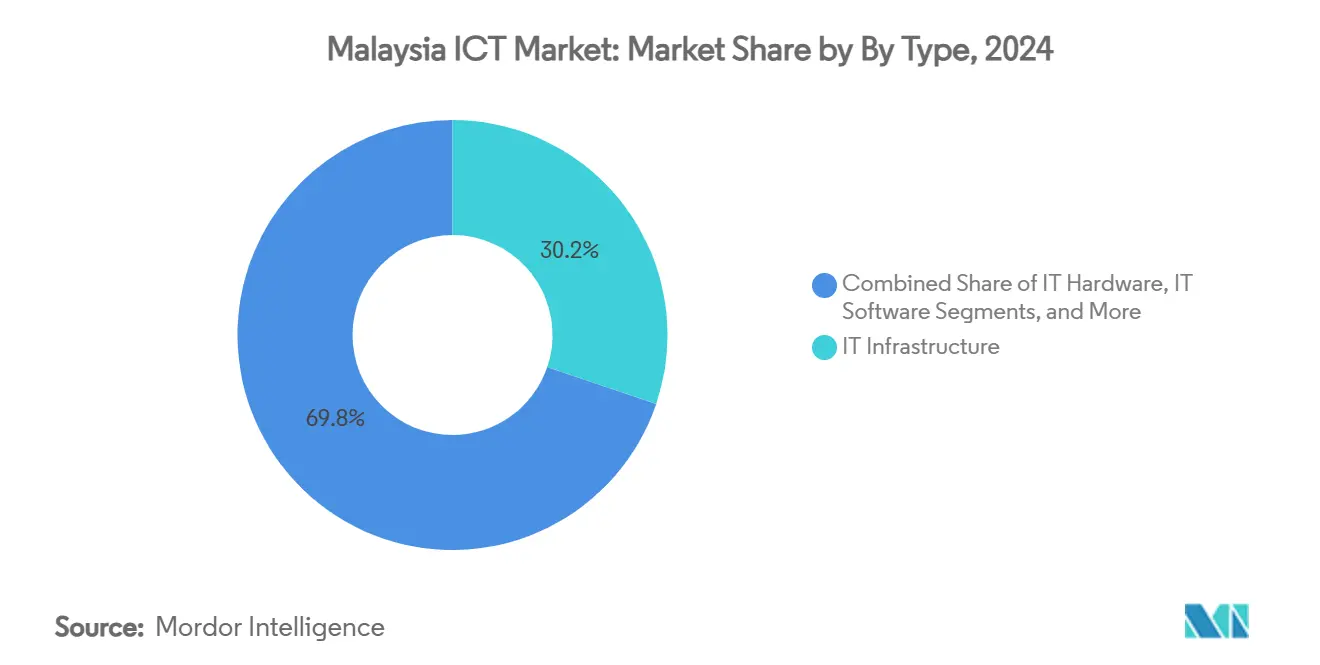
Note: Segment shares of all individual segments available upon report purchase
By End-User Enterprise Size: SME surge realigns sales channels
Large enterprises retained 71.2% revenue in 2024, yet their growth moderates as saturation approaches. SMEs expand at an 11.3% CAGR on the back of grant schemes and simplified SaaS pricing, tilting vendor go-to-market strategies toward volume-driven cloud bundles. The Malaysia ICT market share held by SMEs is projected to climb to 32% by 2030, narrowing the historical dominance of conglomerates. Startup accelerators in Cyberjaya and Penang release vertical niche solutions that map to SME pain points in bookkeeping, logistics, and e-commerce. Banks embed fintech APIs to extend micro-credit, fostering an ecosystem where digital tools unlock new revenue and creditworthiness insights. For suppliers, scalable subscription models replace bespoke deployments, boosting margins and cross-sell potential.
By Deployment Model: Cloud ascent reshapes architecture
On-premise still comprises 59.2% revenue in 2024, chiefly within regulated BFSI and public-sector workloads. Yet cloud deployment races ahead at an 18.2% CAGR, adding USD 9.3 billion to the Malaysia ICT market size between 2025 and 2030. Local hyperscaler zones address latency and data residency concerns while offering AI accelerators that dwarf in-house capacity. Hybrid patterns emerge as banks keep core ledgers on-site but push customer analytics to cloud AI stacks. Edge nodes linked to 5G base stations further disaggregate computing, allowing manufacturers to run latency-sensitive quality checks onsite. Regulatory clarity from MCMC underpins multi-cloud resilience, prompting board-level risk reviews that increasingly favor cloud for disaster-recovery posture.
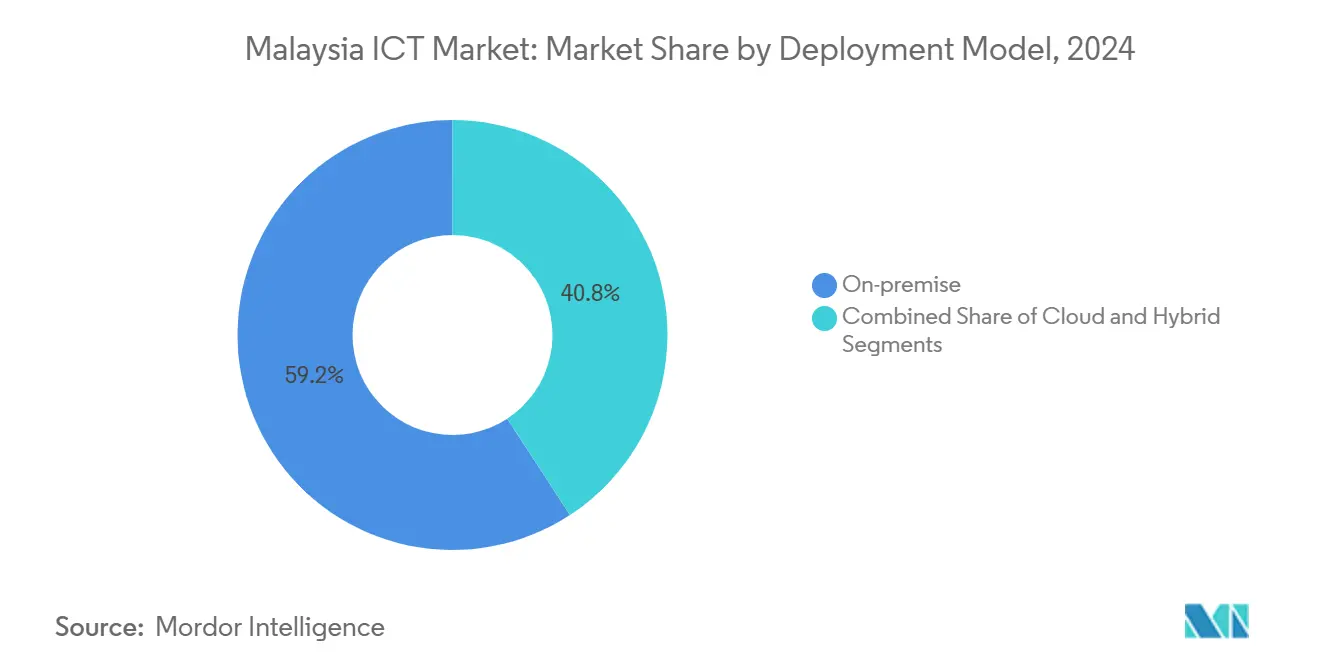
Note: Segment shares of all individual segments available upon report purchase
By End-User Industry Vertical: Manufacturing 4.0 overtakes fintech buzz
BFSI preserved the largest 23.2% slice in 2024, driven by digital banking license awards and robo-advisory rollouts. Manufacturing and Industry 4.0, however, registers the hottest 17.2% CAGR as New Industrial Master Plan incentives subsidize smart-factory retrofits and industrial IoT networks. Infineon’s USD 2 billion silicon-carbide fab in Kulim exemplifies upstream semiconductor gains that ripple through automation suppliers [5]Infineon Technologies, “World’s Largest SiC Power Semiconductor Fab Opens,” infineon.com . Healthcare digitization accelerates through CelcomDigi-AmBank telehealth bundles that bridge urban-rural care gaps. Energy majors such as PETRONAS cooperate with telcos to pilot 5G-enabled predictive maintenance, underscoring cross-sector convergence inside the Malaysia ICT market.
Geography Analysis
Klang Valley commands the lion’s share of spend due to hyperscale data-center clusters and head-office density. Google, Microsoft, and Oracle collectively earmark more than USD 10 billion for new campuses, cementing the locale as an ASEAN cloud hub. Fiber densification and enterprise SaaS adoption follow this investment wave, driving premium colocation demand among regional banks and e-commerce giants.
Penang thrives on semiconductor specialization. Infineon’s Kulim SiC plant and the newly announced Arm design center raise local value added from back-end assembly to front-end design. Coupled with MIDA tax holidays, the corridor becomes a magnet for EDA tools, automation software, and niche cybersecurity vendors that protect IP across fab networks.
East-coast states Sabah and Sarawak trail urban counterparts, but JENDELA subsidies narrow the gap. Submarine cables and shared rural towers lift 4G availability, enabling mobile-first platforms to penetrate the tourism and agriculture sectors. Government e-service kiosks extend cloud-hosted citizen portals, expanding the Malaysia ICT market into frontier localities.
Competitive Landscape
The telecom trio of CelcomDigi, Maxis, and U Mobile forms a stable oligopoly. CelcomDigi’s merger created a 20 million-subscriber behemoth witha USD 1.7 billion brand value. Joint 5G network build-outs reduce duplicate towers and speed rural coverage, freeing capex for enterprise solutions that blend connectivity with IoT analytics.
Cloud and software remain fragmented. Microsoft Azure, Google Cloud, and Oracle Cloud race for government contracts, while AWS maintains developer loyalty through early-mover perks. Local integrators such as Axiata-owned edotco and Accenture’s 45-year Malaysia office translate global templates into regulatory-compliant deployments.
Startups inject competitive tension. AI firm 11x raised USD 24 million Series A to automate contact-center workflows, and fintech challengers tap open-banking APIs. Multinationals respond with venture funds and developer academies, keeping the Malaysia ICT market contestable across service tiers.
Malaysia ICT Industry Leaders
Telekom Malaysia Berhad (TM)
Maxis Berhad
Microsoft Malaysia Sdn Bhd
CelcomDigi Berhad
Amazon Web Services Malaysia Sdn Bhd
- *Disclaimer: Major Players sorted in no particular order
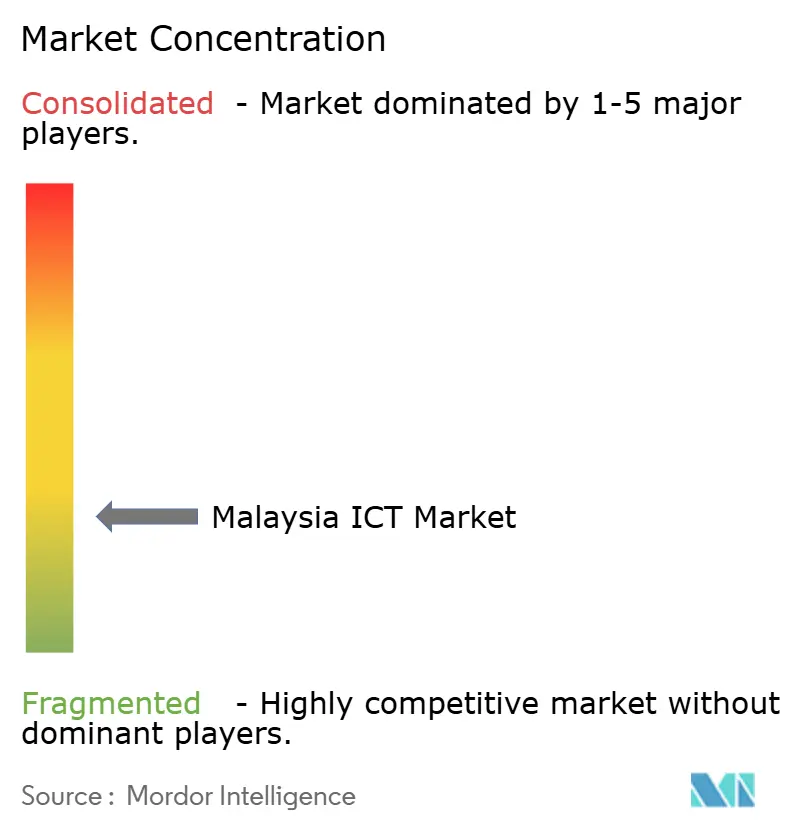
Recent Industry Developments
- March 2025: Malaysia signed a USD 250 million partnership to launch its first ASEAN chip-design office and train 10,000 engineers over the next decade.
- February 2025: Google and the National AI Office began deploying AI tools to 445,000 civil servants.
- February 2025: Vantage Data Centers broke ground on a 256 MW Cyberjaya campus, the country’s largest to date.
- December 2024: Microsoft unveiled an AI-skilling roadmap targeting 800,000 Malaysians.
Malaysia ICT Market Report Scope
The market is defined by the revenue accrued through the sale of ICT offerings, including IT hardware, IT software, IT services, IT infrastructure/data centers, IT security/cybersecurity, and communication services that are being used in various end-user industries across Malaysia.
The Malaysia ICT Market is segmented by type (hardware, software, IT services, telecommunication services), size of the enterprise (small and medium enterprises, large enterprises), and industry vertical (BFSI, IT and telecom, government, retail and E-commerce, manufacturing, energy, and utilities). The report offers market forecasts and size in value (USD) for all the above segments.
| IT Hardware | Computer Hardware |
| Networking Equipment | |
| Peripherals | |
| IT Software | |
| IT Services | Managed Services |
| Business Process Services | |
| Business Consulting Services | |
| Cloud Services | |
| IT Infrastructure | |
| IT Security | |
| Communication Services |
| Small and Medium Enterprises |
| Large Enterprises |
| On-premise |
| Cloud |
| Hybrid |
| Government and Public Administration |
| BFSI |
| Energy and Utilities |
| Retail, E-commerce and Logistics |
| Manufacturing and Industry 4.0 |
| Healthcare and Life Sciences |
| Oil and Gas (Up-, Mid-, Down-stream) |
| Gaming and Esports |
| Other Verticals |
| By Type | IT Hardware | Computer Hardware |
| Networking Equipment | ||
| Peripherals | ||
| IT Software | ||
| IT Services | Managed Services | |
| Business Process Services | ||
| Business Consulting Services | ||
| Cloud Services | ||
| IT Infrastructure | ||
| IT Security | ||
| Communication Services | ||
| By End-User Enterprise Size | Small and Medium Enterprises | |
| Large Enterprises | ||
| By Deployment Model | On-premise | |
| Cloud | ||
| Hybrid | ||
| By End-user Industry Vertical | Government and Public Administration | |
| BFSI | ||
| Energy and Utilities | ||
| Retail, E-commerce and Logistics | ||
| Manufacturing and Industry 4.0 | ||
| Healthcare and Life Sciences | ||
| Oil and Gas (Up-, Mid-, Down-stream) | ||
| Gaming and Esports | ||
| Other Verticals | ||
Key Questions Answered in the Report
How large is the Malaysia ICT market in 2025?
The market stands at USD 28.65 billion and is projected to reach USD 45.32 billion by 2030.
What CAGR is expected for Malaysia’s cloud services segment through 2030?
Cloud deployment is forecast to grow at an 18.2% CAGR.
How are SMEs contributing to digital growth?
SMEs are registering an 11.3% CAGR as grants and tax incentives lower adoption barriers.
Which region captures the highest investment?
Klang Valley commands the biggest share driven by hyperscale data-center builds from global leaders.
